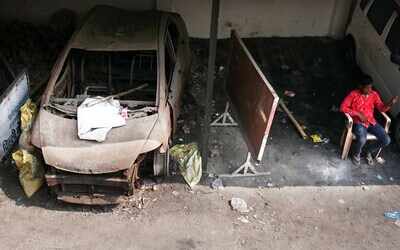Top Searches
- News
- City News
- delhi News
- A year after riots in northeast Delhi: Violence is history, memories are not
A year after riots in northeast Delhi: Violence is history, memories are not
The simmering tensions about the Citizenship Amendment Act and National Register of Citizens gave way to violence in northeast Delhi on February 23, 2020, and continued for some days. In the end, the communal frenzy had claimed 53 lives. Houses were burnt down, businesses were lost, thousands of lives were disrupted by the violence. Life has limped back to near normalcy, but the searing memories are yet to fade away.

Past lingers on in the background
Northeast Delhi, mainly populated by migrant labourers, never drew attention to themselves -- until the communal riots of February 2020 seared their names in public consciousness. A year on, the signs of that violence have been obliterated and the houses do not betray that trauma. And yet, the past lingers on in the background.
Ishrat was single in February last year at the time of her arrest. She came out of jail on interim bail for 10 days to get married. For our mother, it was very difficult to see her newly-wed daughter return to prison with mehndi on her hands
Sarwar Jahan, Ishrat Jahan's sister
Delhi riots: They are accused of conspiracy

The charges against Umar are all fabricated. They say he was the mastermind of the riots, but he was not even present in Delhi at that time. If you see the chargesheet, you can easily discern the charges are fake. The real culprits are free, only the anti-CAA, NRC activists were jailed
SQR Ilyas, Umar Khalid's father
Over 2,000 applications received for property damage

Umar Khalid, Sharjeel Imam: Prime conspirators

A year after riots at Brij Puri

Photo courtesy: Tarun Rawat (TOI)
Over 3,000 applications for compensations received
Around 3,200 applications for compensations were received, of which 2,221 applications were cleared. While 900 were rejected, the remaining are yet to be finalised due to issues like lack of necessary documents. Of the 1,286 claims for damage to residential property, over 300 were rejected because no damage was found during assessment.
A year after riots in Brij Puri

Photo courtesy: Tarun Rawat (TOI)
Kamal Sharma, a riot victim, inside his burnt restaurant

Photo courtesy: Sanjeev Rastogi (TOI)
Chargesheet names Umar Khalid and Sharjeel Imam as prime conspirators
The conspiracy chargesheet names former JNU students Umar Khalid and Sharjeel Imam and sacked AAP councillor Tahir Hussain as prime conspirators. The cops have alleged that Khalid fostered nationwide alliances with ‘like-minded people’ soon after CAA received cabinet assent for being placed before Parliament. Police have accused him of mentoring formation of a group called Muslim Students of JNU through a protege, Sharjeel Imam, which played a major role in fomenting the riots. Khalid, cops allege, “remotely controlled” the happenings of February 23-24. Activists like Natasha Narwal, Devangna Kalita, Safoora Zargar and others were also caught.
A building which was burnt by the rioters in Maujpur

Photo courtesy: Sanjeev Rastogi (TOI)
Rafeek, a riot victim at Maujpur

Photo courtesy: Sanjeev Rastogi (TOI)
'Rioters assembled in front of my home and destroyed my shop'
Electric appliances seller Jagroshan Kumar also recalls how rioters assembled in front of his home and destroyed his shop. His family members locked themselves in the house and managed to escape the threat to their lives when the police arrived the next day. “The mob broke down my shop’s shutter and looted everything on February 24,” said the man, who got just Rs 45,000 from the government.
A restaurant after one year of riots at Delhi's Yamuna Vihar

Photo courtesy: Sanjeev Rastogi (TOI)
Probe tools used by police

1,825 arrested for the riots
So far, 1,825 accused have been arrested by the SITs, Special Cell and the North East district police. Two hundred and thirty one people were arrested on the basis of CCTV/mobile footage, of which 137 were identified through the facial recognition system matched with criminal records and 94 identified through driving licence photographs.
A year after north east Delhi riots at Moonga Nagar

Photo courtesy: Tarun Rawat (TOI)
A year after north east Delhi riots at Brij Puri

Photo courtesy: Tarun Rawat (TOI)
What happened in Jaffrabad
In Seelampur, hawkers today set up wares along the pavements where over 500 women gathered every day a year ago to protest against the Centre’s Citizenship Amendment Act (CAA). Spray-painted slogans of resistance that once stood out against whitewashed walls have faded, but memories of a “revolution” are fresh in the minds. The riots broke out near Jaffrabad metro station on February 23, and eventually killed 53 people, maiming over 500 others.